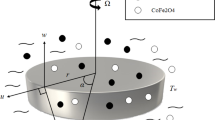Abstract
Recently, a novel way of driving rapid microcentrifugation was discovered using ionic wind via ionization of the atmosphere around a singular electrode tip, driving liquid recirculation in a small cylindrical cavity due to interfacial shear. In the original work, the primary azimuthal surface recirculation was speculated to drive a secondary flow in the bulk of the liquid which resembles a helical swirling flow that tapers toward a pseudo-stagnation point at the cavity floor, analogous to Batchelor flows between co-axially placed stationary and rotating disks. Here, we employ microParticle Image Velocimetry (microPIV) together with numerical simulations to verify this speculation. Good qualitative and reasonable quantitative agreements were obtained between the experiments and numerical simulations. In both, we were able to capture salient features of the three-dimensional flow; for the experiments, this was achieved by the reconstruction of the three-dimensional flow field from the planar two-dimensional velocity fields obtained in a confocal-like manner. In addition, we formally quantify the micromixing enhancement first demonstrated, but not quantified, in the original experiments. Our results show a mixing enhancement close to two orders of magnitude approaching vigorous mixing intensities as the surface vortices suffer from various instabilities leading towards their breakdown into subvortices at large applied voltages and AC frequencies, reminiscent of that in the original work.













Similar content being viewed by others
References
Arifin D, Yeo L, Friend J (2007) Microfluidic blood plasma separation via bulk electrohydrodynamic flows. Biomicrofluidics 1:014103
Batchelor G (1951) Note on a class of solutions of the Navier–Stokes equations representing steady rotationally-symmetric flow. Q J Mech Appl Math 4:29–41
Benton E, Clark A (1974) Spin-up. Annu Rev Fluid Mech 6:257–280
Chen C, Santiago J (2002) A planar electroosmotic micropump. J Micromech Microeng 11:672–683
Ducree J (2008) Centrifugal microfluidics. In: Li D (ed) Encyclopedia of microfluidics and nanofluidics. Springer, New York
Greenspan H (1968) The theory of rotating fluids. Cambridge Univeristy Press, Cambridge
Guigan J (1998) Method and apparatus for obtaining and delivering a predetermined quantity of plasma from a blood sample for analysis purpose. U.S. Patent No. 4788154
Haeberle S, Brenner T, Zengerle R, Ducree J (2006) Centrifugal extraction of plasma from whole blood on a rotating disk. Lab Chip 6:776–881
Hutchinson B, Raithby G (1986) A multigrid method based on the additive correction strategy. Numer Heat Transf 9:511–537
Kawamoto H, Umezu S (2005) Electrohydrodynamic deformation of water surface in a metal pin to water plate corona discharge system. J Phys D 38:887–894
Khomenko G, Babiano A (1999) Quasi-three-dimensional flow above the Ekman layer. Phys Rev Lett 83:84–87
Kinoshita H, Kaneda S (2007) Three-dimensional measurement and visualization of internal flow of a moving droplet using confocal micro-PIV. Lab Chip 7:338–346
Laser D, Santiago G (2004) A review of micropumps. J Micromech Microeng 14:35–64
Li D (2004) Electrokinetics in microfluidics. Academic Press, London
Loeb L (1965) Electrical corona. University of California Press, Berkeley
Madou M, Zoval J, Jia G, Kido H, Kim J, Kim N (2006) Lab on a CD. Annu Rev Biomed Eng 8:601–628
Nguyen N, Wereley S (2006) Fundamentals and applications of microfluidics, 2nd edn. Artech House, Boston
Ohyama RI, Kaneko K, Chang JS (2003) Flow visualisation and image analysis of gas-phase ac corona discharge induced electrohydrodynamic liquid flow in a stratified fluid. IEEE Trans Dielectr Elec Ins 10:57–64
Pao HP (1972) Numerical solution of the Navier–Stokes equations for flows in the disk‐cylinder system. Phys Fluids 15:4–11
Papautsky I, Asgar A, Bhagat S (2008) Microscle flow visualization. In: Li D (ed) Encyclopedia of microfluidics and nanofluidics. Springer, New York
Pugia M, Profitt J, Schulman L (2004) Method and apparatus for separation of particles in a microfluidic device. W.O. Patent No. 2004/061413
Raghavan R, Friend J, Yeo L (2009) Particle concentration via acoustically-driven microcentrifugation: microPIV flow visualisation and numerical modelling studies. Microfluid Nanofluid. doi:10.1007/s10404-009-0452-3
Raw M (1996) Robustness of coupled algebraic multigrid for the Navier–Stokes equations. AIAA Technical Paper 96-0297 (American Institute of Aeronautics and Astronautics, Reston, VA, USA)
Shelby J, Lim D, Kuo J, Chiu D (2003) Microfluidic systems: high radial acceleration in microvortices. Nature 425:38
Tan M, Friend J, Yeo L (2007) Surface acoustic wave driven microchannel flow. In: Proceedings of the 16th Australasian Fluid Mechanics Conference, Gold Coast, QLD, Australia, pp 790–793
Wang P, Chen Z, Chang HC (2006) A new electro-osmotic pump based on silica monoliths. Sens Actuators B 113:500–509
Wang SC, Lai YW, Ben Y, Chang HC (2004) Microfluidic mixing by dc and ac nonlinear electrokinetic vortex flows. Ind Eng Chem Res 43:2902–2911
Yeo L, Friend J (2009) Ultrafast microfluidics using surface acoustic waves. Biomicrofluidics 3:012002
Yeo L, Friend J, Arifin D (2006a) Electric tempest in a teacup: the tea leaf analogy to microfluidic blood plasma separation. Appl Phys Lett 89:103516
Yeo L, Hou D, Maheshswari S, Chang HC (2006b) Electrohydrodynamic surface microvortices for mixing and particle trapping. Appl Phys Lett 88:233512
Acknowledgment
Funding for this project through the Australian Research Council Discovery Project DP0985253 is acknowledged.
Author information
Authors and Affiliations
Corresponding author
Rights and permissions
About this article
Cite this article
Qin, J.J., Yeo, L.Y. & Friend, J.R. MicroPIV and micromixing study of corona wind induced microcentrifugation flows in a cylindrical cavity. Microfluid Nanofluid 8, 231–241 (2010). https://doi.org/10.1007/s10404-009-0459-9
Received:
Accepted:
Published:
Issue Date:
DOI: https://doi.org/10.1007/s10404-009-0459-9




